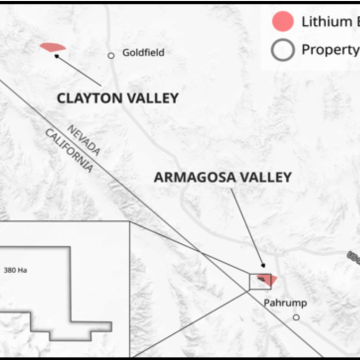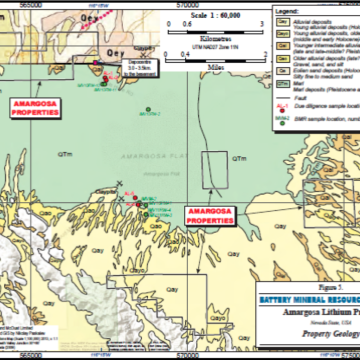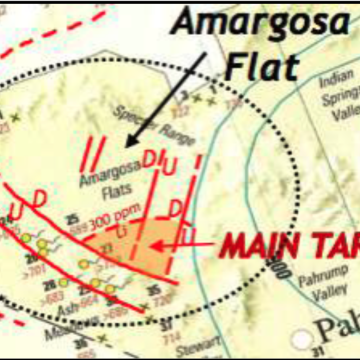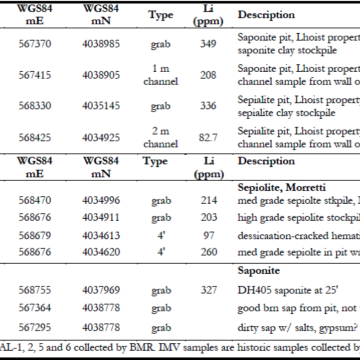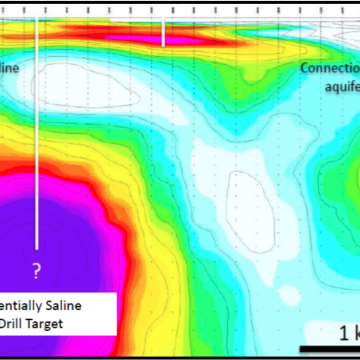USA - Nevada Lithium
The Amargosa Lithium project is in the southern Basin & Range province and central Mojave Desert of Nevada.
The Amargosa property is a hydro-geological sink, surrounded by lithium leaching volcanics which is a similar setting to the nearby Clayton Valley Lithium deposit.
Amargosa is an early-stage exploration opportunity in a favourable region that hosts numerous lithium occurrences and the Clayton Valley Lithium deposit owned by Cypress Development Corp that hosts and indicated resources of 1,304.2Mt grading 905ppm lithium for 1,179.9MKg lithium and inferred resources of 236.4Mt grading 759.6ppm lithium for 179.6Mkg lithium (August 5, 2020, NI 43-101 Clayton Valley Technical Report Cypress Development Corp.).
USA - Nevada Lithium
The Amargosa Lithium project is in the southern Basin & Range province and central Mojave Desert of Nevada.
The Amargosa property is a hydro-geological sink, surrounded by lithium leaching volcanics which is a similar setting to the nearby Clayton Valley Lithium deposit.
Amargosa is an early-stage exploration opportunity in a favourable region that hosts numerous lithium occurrences and the Clayton Valley Lithium deposit owned by Cypress Development Corp that hosts and indicated resources of 1,304.2Mt grading 905ppm lithium for 1,179.9MKg lithium and inferred resources of 236.4Mt grading 759.6ppm lithium for 179.6Mkg lithium (August 5, 2020, NI 43-101 Clayton Valley Technical Report Cypress Development Corp.).
Amargosa
Key Facts
Overview
The Amargosa project is in Nye County, Nevada—about 100km northwest of Las Vegas (population ~600,000 people), 35km northwest of Pahrump (population ~36,000 people).
The Amargosa project is situated in the Basin and Range province of Nevada that is among the most prolific mining jurisdictions in the world. Power, transportation and skilled mining labor are readily available in the region.
Regional mineral occurrences include the Hectorite and Sepiolite/Saponite clays and zeolites previously mined at Franklin Wells and the currently mined Sepiolite/Saponite clays mined by Lhoist in the immediate vicinity of the Amargosa property.
Bentonite has been produced from deposits in the area and Borax was previously mined in the Death Valley and is currently mined at Borax, CA. These regional deposits are evidence of the volcanic origin and alteration of the deposits.
Amargosa is an early-stage exploration opportunity in a favourable region that hosts numerous lithium occurrences. The regional structural geology has characteristics like the Clayton Valley Lithium deposit, a producing Lithium brine operation. The geological model proposed for the Amargosa property is similar, with convergent faults forming a “brine trap” at depth.
Historical Background
Sepiolite, Saponite and Bentonite clays have been extracted from various clay pits in the Amargosa since the early 1920s.
IMV Nevada, a subsidiary of Lhoist North America, currently extracts Sepiolite and Bentonite clays from several pits in the Ash Meadows-Amargosa Flat area. Production in 2014 was reported as 129,700 tonnes (143,000 short tons; Nevada Minerals Yearbook, 2016). The clays occur in shallow, flat-lying deposits in Pliocene lacustrine sediments.
Anomalously high Lithium values were discovered in clay minerals in Clayton Valley, Nevada in the early 1960s, approximately 190 km northwest of the Amargosa project.
Geology & Mineralization
The property area is a playa lake. The region is underlain by felsic volcanic rocks, one of the prime source rocks for Lithium brines. The geology of the project area is conducive for Lithium brine mineralization.
Significant lithophile ash zones are located to the west and north of the property area. These lithophilic ash zones are relatively deeply buried and if not altered to clay are typically transmissive and permeable for groundwater flow.
The Amargosa property is a closed basin with favorable structure and geometry apparently trapping fluids.
Groundwater flow direction is towards the east and south, with a gravity low located in the centre of the project area. Regional gravity data indicates the depth to basement rock ranges of 3.0 km to 3.5 km.
Hydrogeological data indicates significant groundwater flow may be present.
The deposit model for economically viable Lithium brine deposits is relatively simple: Lithium is leached from suitable source rocks or introduced from Lithium-rich hydrothermal fluids, is trapped in a hydrologically closed basin, and is concentrated in the fluid by evaporation.
Productive brines containing 200ppm – 1,400ppm Lithium are pumped from subsurface aquifers, further concentrated by evaporation on surface, and then processed to remove Lithium as carbonates or metal. It is important to be clear that the targets in these deposits are not Lithium-bearing rocks or clays, but subsurface Lithium-rich brines contained in permeable aquifers.
The deposit type proposed for the Amargosa property is that of a lithium brine deposit model based on the Clayton Valley deposit.
Current Exploration
BMR work to date has included geological mapping, selective sampling and a Magnetotelluric geophysical survey. This survey defined drill targets within the basin.
Line 3 of the Amargosa magnetotellurics (MT) survey shows a near surface (<300 metre deep) anomalous brine trending over one kilometer. Lithium clays are mined by Lhoist from surface deposits not far from this target. An extremely saline water reservoir is located at depth and this is interpreted as a buried geothermal system which may offer exploration/development opportunities for both green geothermal energy generation as well as lithium extraction.
Drilling has not occurred on the Amargosa property. Shallow drilling has occurred at the clay mine adjacent to the Amargosa project, but no deep holes have been drilled to test for the presence of lithium brines.
Technical Report
January 2017: Amargosa Lithium Project Nye County Nevada by D. H. Hains; Hains Engineering Limited, prepared for Battery Mineral Resources

